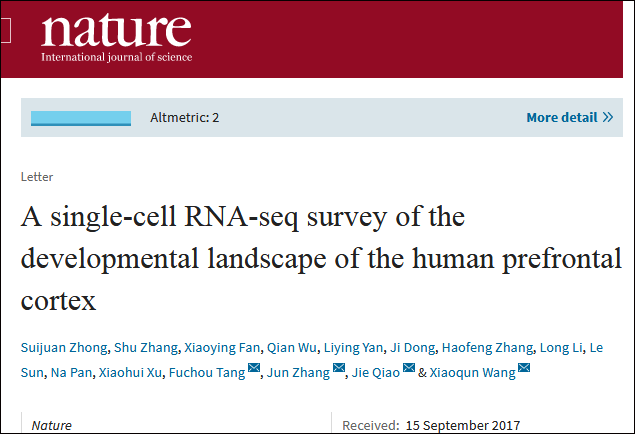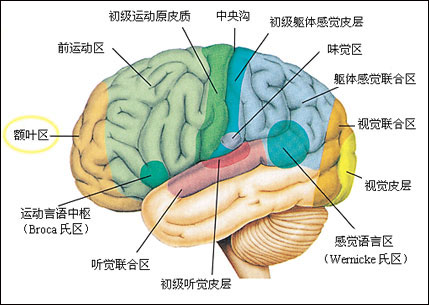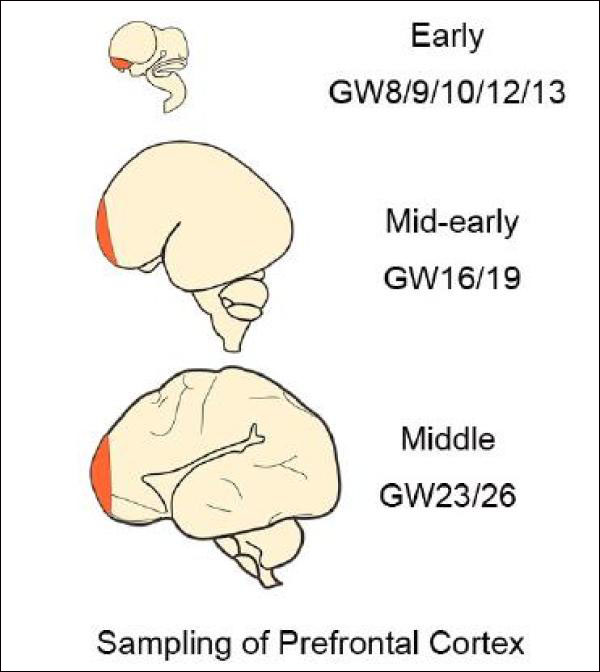"We can explore the universe a few years away, but we don't know much about the three-pound brain between our ears." This idea prompted former US President Barack Obama to launch the "Innovative Neurotechnology Brain Research Program."
Research in the same field in China is also accelerating. At present, the United States "brain plan cell map" is mainly concentrated in rodents, and China has included the dynamic process of human brain prefrontal development, which will provide the most direct reference for the study of human brain development and disease.
According to the news network reported on March 15, Beijing time on March 15th, the top academic journal Nature has published an article "A single-cell RNA-seq survey of the developmental landscape of the human prefrontal cortex" ( Single-cell RNA sequencing studies on human prefrontal cortical development).

On March 15th, Nature published a Chinese scientist's prefrontal research paper (Source: Screenshot of Nature's website)
The author of the paper is Professor Wang Xiaoqun from the Institute of Biophysics of the Chinese Academy of Sciences, Professor Tang Fufu from Peking University, Professor Qiao Jie and Professor Zhang Jun from Anzhen Hospital. Wang Xiaoqun is also the chief scientist of the National Major Scientific Research Program “Research on the Determining Mechanism and Function of Adult Neural Stem Cells†from 2014 to 2018.
In an interview, Wang Xiaoqun said, "This study is the first to systematically study the cellular and molecular mechanisms in the formation of prefrontal cortex during human prefrontal cortex (PFC) development. It should be said that our work is already better than the US brain plan. The cell map section is 'a quick step.'
The brain is a key component of the advanced function of the human brain in the prefrontal cortex. It is called the "central processor" of the human brain. From the advancement of primate ancestors to modern humans, brain capacity has doubled, and the increase is mainly reflected in the increase in the area of ​​the prefrontal cortex. The human prefrontal cortex accounts for one-third of the total area of ​​the cerebral cortex.

Source: Social media screenshots
Functionally speaking, the prefrontal cortex is responsible for the high-level intellectual activity of the human brain and is an important material basis for human thought. Mainly involved in memory formation, short-term storage and retrieval functions, language functions, cognitive ability, behavioral decision-making, emotional adjustment and other functions.

Human brain frontal area (Source: Social media screenshot)
However, the embarrassing situation in front of scientists has long been to explore the mysteries of the brain, but at the same time it is not clear how many cells are formed by the brain. "Although everyone says that the brain has all kinds of functions, we don't know how many cells are in the brain. The basic cell composition is not known, so it is difficult to understand how the brain's advanced cognitive function is. Come." Wang Xiaoqun said.
How does the human brain "CPU" develop during 8-26 weeks of gestation?
The paper mentions that although the neural circuit is formed in the late stage of human embryo development and even after human birth, cells with different functions form and migrate to the corresponding regions during embryonic development.
To obtain systematic, dynamic neural cell development, the team analyzed more than 2,300 single cells by RNA sequencing. These single cells are derived from the human prefrontal cortex, which is still developing at 8-26 weeks of gestation.
In the end, Wang Xiaoqun and his colleagues identified six major types of cells in a total of 35 subtypes and tracked the developmental trajectories of these cells. "We found that in the dynamic development of human prefrontal cortex, mainly from neural stem cells, excitatory neurons, inhibitory neurons, astrocytes, oligodendrocytes, microglia, etc. Cell composition, and further divide these six types of cells into 35 independent cell subtypes."
It is clear that the cell composition is only the cornerstone. "We continue to reconstruct the developmental lineage between these neuronal cell types using algorithms such as quasi-time and found that neural stem cells in the prefrontal cortex are a highly complex heterogeneous functional cell population in different embryonic developments. The stages differentiate into neuronal cells, astrocytes, and oligodendrocytes, respectively. Wang Xiaoqun said.
Subsequently, through more in-depth functional analysis, the researchers discovered a series of key gene expression features closely related to the three important neurodevelopmental events of neural stem cell symmetry, neuronogenesis and glial cell development, and carried out in-depth, systematic Experimental verification.
In addition, in recent years, in the study of human neural stem cells, scientists have focused on radioactive glial cells. Wang Xiaoqun et al. believe that intermediate precursor cells (IPC) also play an important role in neurogenesis, especially in primates.
Through systematic data analysis and multi-level experimental verification, the researchers suggest that the production of intermediate precursor cells has two critical outbreaks. "One is about 10 weeks after embryonic development. These intermediate precursor cells are mainly produced by radial glial cells (RG), while the other peak occurs at about 16 weeks of embryonic development. These intermediate precursor cells are made of external radial glue. The cytoplasmic cells (oRG) are produced in large quantities," explains Wang Xiaoqun. "It is through the formation of these two bursts of intermediate precursor cells that a large number of neurons can be rapidly formed during the development of the transient cerebral cortex and form a structure. Complex, feature-rich prefrontal cortex."
Through systematic analysis and deep mining of neuronal single-cell transcriptome data, the research team also revealed for the first time three key stages of excitatory neuron production, migration and maturation during the development of the human prefrontal cortex.

Three stages of excitatory neuron production, migration and maturation during the development of the human prefrontal cortex (Source: 澎湃News)
The first stage, 8-12 weeks of gestation, is a stage of massive proliferation of neural stem cells. In the second stage, 13-16 weeks of gestation, neural stem cells differentiate and produce a large number of new neurons accompanied by the migration phase of new neurons. In the third stage, 19-26 weeks, the neurons begin to mature, express key functional proteins and initially form a stage of functional neural networks.
In order to verify whether the above-mentioned preliminary neural network has function, Wang Xiaoqun and others used electrophysiology and other means to conduct in-depth functional research on the 26-week prefrontal cortex in human perinatal period. It was found that many neurons in the prefrontal cortex at 26 weeks of gestation had the ability to normally deliver sodium-potassium currents, and neurons in the deep brain regions were more likely to issue EPSC (excitatory postsynaptic currents) and IPSC (inhibition). Sexual postsynaptic current) and other functions.
"In the past, the scientific research on human prefrontal lobe was almost blank. We have basically explained the cell type and the dynamics of each cell development through solid work." Wang Xiaoqun concluded, "This is how to answer the prefrontal cortex." Subsequent research on the key issue of 'thinking and thinking formation' provides high-precision cell maps and is an important breakthrough and significant advance in the history of prefrontal cortical development."
"A step faster than the American Brain Plan Cell Atlas"
Since April 2, 2013, the planned 10 years of the US BRAIN Initiative has been in operation for nearly five years. Now, what is the latest progress in the US "brain plan" research?
According to the Observer Network’s earlier reports, new achievements in the new “Brain Project†project in the United States have appeared frequently in recent years. For example, in August 2016, researchers at the University of Washington in St. Louis mapped out the most comprehensive and accurate human brain map to date, with 97 human cerebral cortical areas first published.
The Speaking of Research website, which is dedicated to providing accurate animal research medical information, recently reported that the US Congressional Neuroscience Core Group is currently proposing that the "brain plan" should strengthen animal research, using the latest physiological and anatomical techniques to determine the behavior of specific neural circuits. influences.
The two heads of the National Institutes of Health said that "zebrafish, rodents and non-human primates play an important role in the research and development of the 'brain plan', and future animal research will test the application of new technologies in humans. It is also crucial."

Source: Screenshot of Speaking of Research website
Wang Xiaoqun and his team took the lead in drawing the dynamic development process of the human brain "CPU". What is the level of this result compared with the "cell map part of the brain plan" in the United States?
According to the news report, Wang Xiaoqun said, "The US 'brain plan cell map' is still mainly focused on rodents, and we include the dynamic process of human prefrontal lobe development." This will provide the most direct reference for the study of human brain development and disease.
Wang Xiaoqun believes that with the publication of the results of his research team, China's research in this area "should be one step faster than the American brain plan."
The "Promoting Innovative Neurotechnology Brain Research Program" ("brain plan") announced by Obama is another major research project aimed at human problems after the Human Genome Project. The program aims to strengthen the understanding of the human brain through innovative neural techniques. The ultimate goal is to find new ways to overcome brain diseases, including Alzheimer's disease, epilepsy, Parkinson's disease and so on.
It is worth mentioning that the United States has invested heavily in the "brain plan." In the fiscal year budget when the Brain Plan was launched, the US Defense Advanced Research Projects Agency, the National Institutes of Health, and the National Science Foundation invested a total of approximately $100 million in research funding for the program. By 2017, the budget for the “brain plan†in the fiscal year budget has increased to $434 million, more than four times that of 2014, and the growth rate has reached nearly 45% compared to fiscal 2016.
Wang Xiaoqun mentioned that compared with the United States, China’s investment in the “brain plan†is still uncertain. "I hope that the country can support it. As a young scientist, we must do our best and concentrate on it."
In addition, if China wants to lead in the "brain planning cell map", teamwork of interdisciplinary and related talents is very important. "In terms of brain cell single-cell sequencing, it requires interdisciplinary collaboration, such as cell biology. Talents such as neuroscience and computational science work together to gather the advantages of various talents and call for people from different disciplines to work together. Therefore, there are fewer laboratories in this direction in China, calling for more laboratories to join."
The paper shows that Wang Xiaoqun's latest research is done in collaboration with Tang Fuyue, a researcher at the Biodynamic Optical Imaging Center of Peking University. According to Wang Xiaoqun, Professor Tang Fufu published a single-cell sequencing method in 2009, and he was one of the first people to start single-cell sequencing worldwide. Based on the complementary advantages of both parties and the accumulation in the early stage, Wang Xiaoqun and others spent only one and a half years from the beginning to the submission.
"It's still very efficient. If there is more support, we can even do it faster and deeper. Not only the prefrontal lobes, but also other brain regions can be described one by one." Wang Xiaoqun said, "At the moment, we just do the genes." Expression map, in the future I want to continue to study the apparent regulation map of brain development, so that through the combination of gene expression profile and apparent regulation map, we can help us to understand how the prefrontal cortex is formed in the future." (Observer network )
Garlic Powder,Garlic To Garlic Powder,Black Garlic Powder,Minced Garlic To Garlic Powder
shandong changrong international trade co.,ltd. , https://www.cragriculture.com